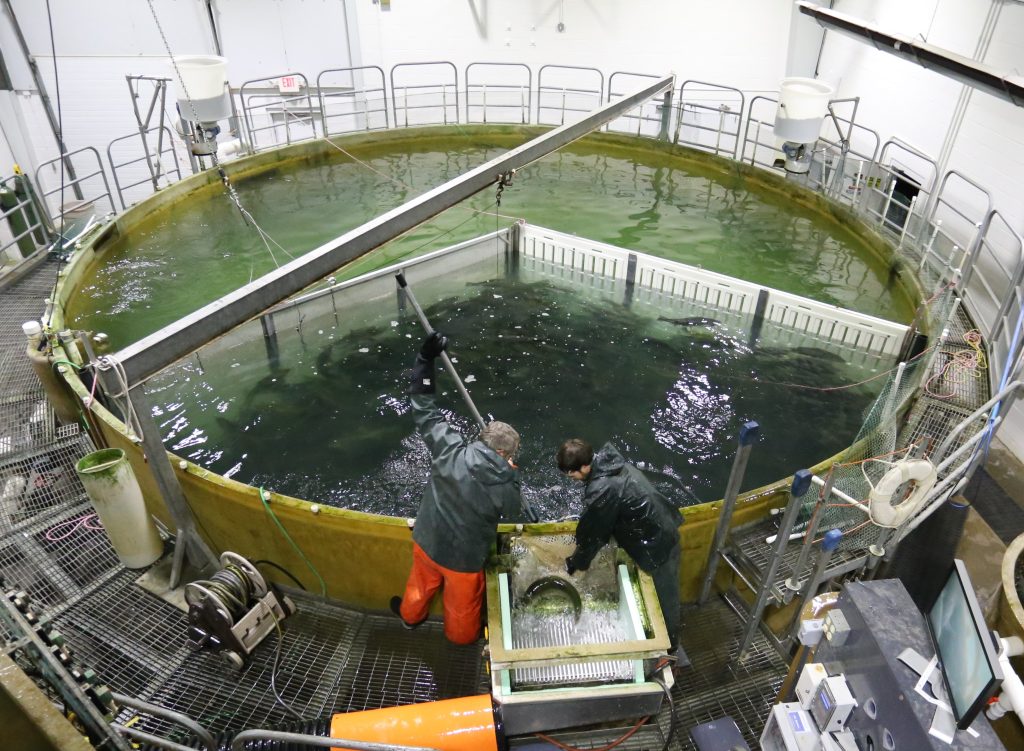
Features
Fresh Tips: Five freedoms of animal welfare in RAS
October 16, 2023 By Curtis Crouse, Freshwater Institute
 Crowded tank harvest (Photo: Freshwater Institute)
Crowded tank harvest (Photo: Freshwater Institute) Favourable fish growth and performance metrics do not necessarily confirm that acceptable fish health and welfare standards have been maintained. However, maintaining good fish health and welfare will generally result in favourable fish growth and performance metrics.
One way for RAS facilities to differentiate between the two goals is to frame fish health and welfare procedures within the Farm Animal Welfare Council’s five freedoms benchmark, which forms the basis of many international animal welfare protocols.
Ensuring good fish welfare in the RAS will yield better performance, preserve public opinion of the industry, and appeal to growing numbers of consumers becoming more conscious of humanely raised standards. Below are some considerations for how RAS operators can provide for each of the five freedoms.
Freedom from hunger (and thirst)
In the case of fish, the focus of the first freedom is providing an appropriate diet and ration. Diet selection should consider the nutritional requirements of the fish based on species, life stage, and weight.
Appropriate feed storage will maintain the nutritional integrity and wholesomeness of diets prior to use. Feed pellet size should also be such that all fish in the population are able to capture and consume the feed.
Finally, automatic feeding events should be frequent and large enough to satiate all the fish in the tank if not using on-demand feeders. Providing adequate nutrition and ration will also help optimize fish growth and reduce aggressive behaviour.
Freedom from discomfort
The second freedom outlines that an appropriate environment is provided to the animal. The water quality and temperature in the culture tank should thus be within normal ranges for the species grown.
Critical water quality parameters should be continuously measured and set to alarm if outside of thresholds. A tested alarm response protocol and adequate spare parts will help technicians quickly bring the environmental parameters back within range.
Additional monitoring with regularly scheduled tests for parameters such as nitrogen wastes and solids can help operators maintain healthy environments. Maintaining optimal water quality and preventing sudden changes will reduce stress in the population and provide the best possible growing conditions.
Freedom from pain, injury, or disease
Providing freedom from pain, injury, or disease centers around implementing strong disease prevention and diagnosis procedures. The first line of defense is good biosecurity protocols including sanitation, disinfection, vaccination, and movement procedures that prevent the introduction of pathogens into the facility.
If changes in behaviour, concerning mortality trends, or early signs of illness are observed, a veterinarian should be consulted and prescribed treatments administered promptly to alleviate stress and prevent the spread of disease. Individual fish exhibiting signs of pain or distress could be removed from the population.
Having a disease monitoring plan with contact information for a local veterinarian or diagnostic lab can help reduce reaction time if a disease outbreak occurs in the RAS. The culture tank, fish moving equipment, or any other item that may contact the fish should also be regularly inspected for sharp edges or any other hazards that could cause injury to a fish.
Minimizing the loss of both fish numbers and growth from a disease will help keep production goals on schedule.
Freedom to express normal behaviour
Freedom to express normal behaviour is facilitated by providing animals with sufficient space and access to social interactions with others.
Necessary space for fish can consist of rearing in appropriately sized culture tanks and maintaining prescribed biomass stocking density that allows fish the opportunity to turn around, move side to side, up, and down in the water column, and swim freely.
Water velocity should also be considered based on the normal swimming behaviour of the species cultured. In a correctly sized and stocked culture tank, fish should be able to have normal social interactions with others and likewise be able to flee and avoid negative interactions when necessary.
Freedom from fear and distress
A proper animal welfare mindset from the operator and accommodating the first four freedoms will go a long way to preventing mental suffering and distress.
Staffing well-trained and observant technicians that can spot signs of distress can help quickly alleviate potential problems. Minimizing contact with the fish is also a good way to reduce opportunities for stress. However, tank-side work and fish transfer/harvest events will be necessary.
Limit this time when possible and avoid brightly coloured clothing or sudden lurching movements that elicit startle responses. When moving fish, crowd them only as tight as needed to complete the task and avoid overloading nets. Strive to minimize the time fish spend in nets and out of water.
When handling fish, always do so in a gentle manner. Consider anesthetics and therapeutics for longer moves or hauls and pain relief for invasive procedures.
Finally, fish should always be harvested using humane methods that minimize stress and preserve product quality.
Print this page